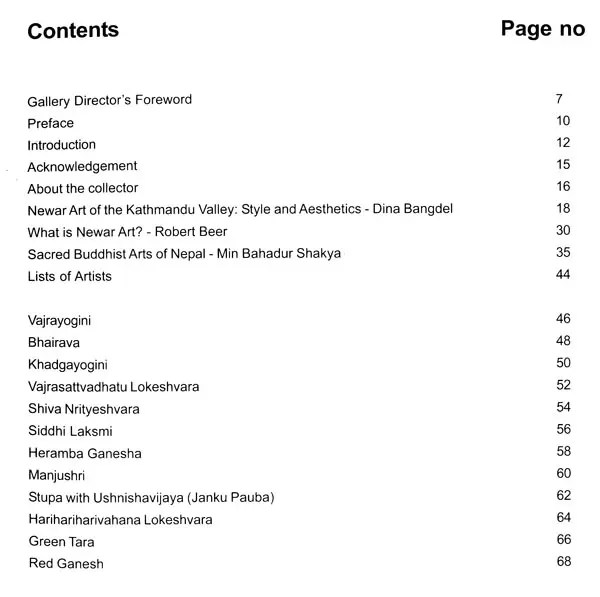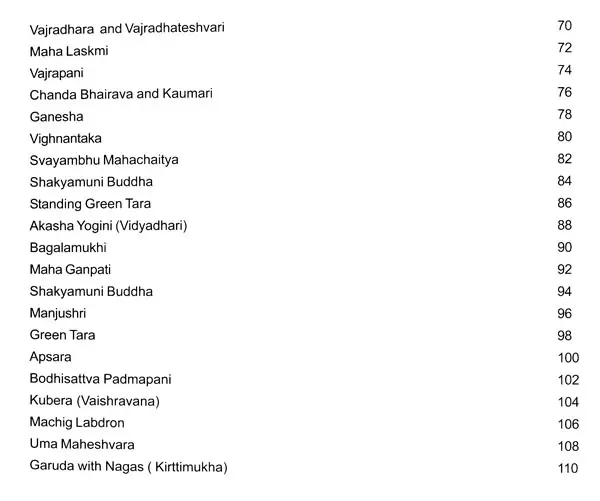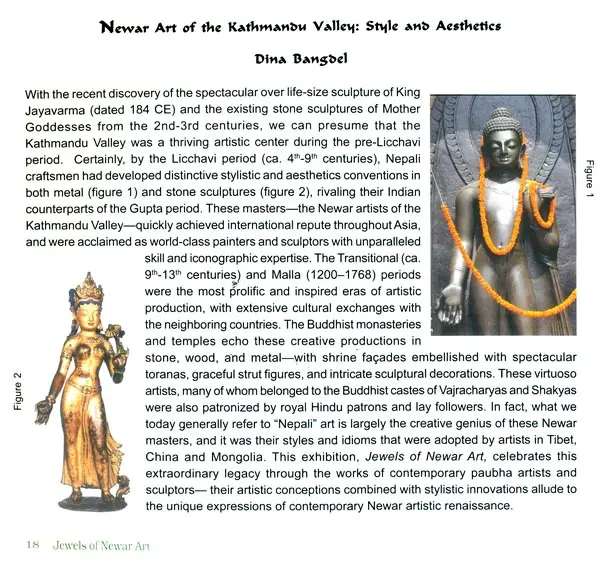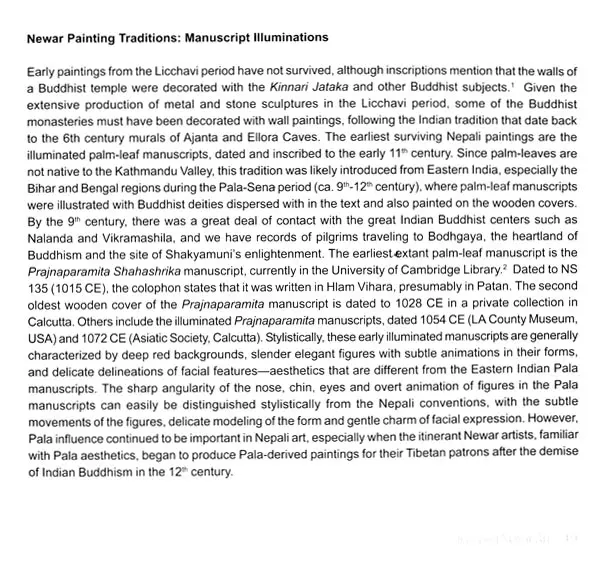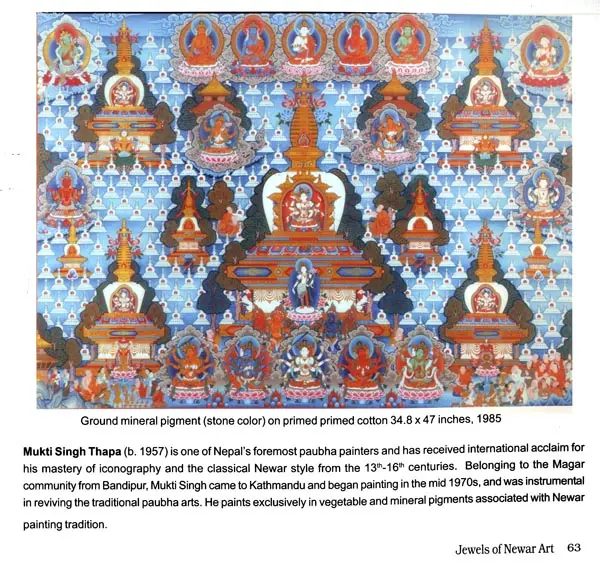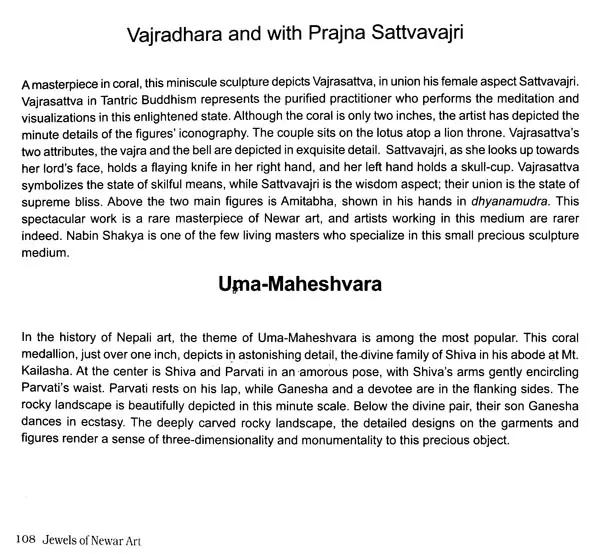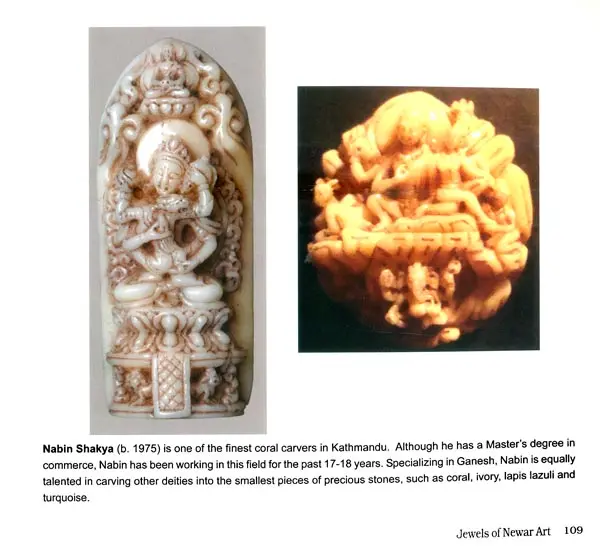
Jewels of Newar Art- Selections from the Collection of Purna and Anjana Shakya
Book Specification
| Item Code: | UAJ405 |
| Author: | Dina Bangdel |
| Publisher: | Bodhisattva Gallery, Nepal |
| Language: | English |
| Edition: | 2011 |
| ISBN: | 9789937234283 |
| Pages: | 112 (Throughout Color Illustrations) |
| Cover: | PAPERBACK |
| Other Details | 8.00 X 8.50 inch |
| Weight | 400 gm |
Book Description
Since the arts are an integral part of Newar culture, Bodhisattva's commitment to support Newar arts is an endeavor to give continuity to these artistic and cultural traditions and is indeed laudable. This exhibition will also showcase statue molds by Bodhi Raj Shakya and-family, Sanu Raja Bajracharya and Babu Kaji Bajracharya. Small selection of exquisite carvings by Sanu Raja Bajracharya and Suman Shakya, coral pieces by Nabin Bajracharya and gold repousee work by Rajendra Shakya will also be exhibited The art critic Madan Chitrakar writes that "paubha paintings were originally executed by the indigenous Newar people of Nepal to depict Buddhist and Hindu gods and mandalas. They originated around the 11th century and developed a unique style before influencing the formation of the Thangka paintings in Tibet." Tragically, many paubha masterpieces, some of which date back as far as the 12th century are in private collections in Europe and USA.
In the early 1970s the Government of Nepal formulated policies to promote paubha thangka painting, religious statuary and traditional jewelry making, in a bid to "encourage Nepalese artisans to adopt handicraft production as their profession by preserving Nepalese cultural heritage and to popularize it in the World". Ironically, the traditional spiritual and religious art of the Newars was categorized as 'handicraft' by the state during this period. The commercialization of this art form meant that new artists from different communities stepped in to meet the demand for thangkas from private collectors and Buddhist monasteries around the world. These dynamics meant that the tradition of oral transfer of knowledge, which was kept secret within the circle of the family, and that which was passed on from master to disciple, changed forever. The demand for thangkas in the monasteries of East Asia meant that Nepali artists also adopted decidedly Oriental motifs and expressions in their work.
This commercialization also impacted the traditional spiritual prerequisites involved in paubha I thangka painting: "A cloth is to be woven by a pure virgin and its presentation is accompanied by an elaborate ritual. An officiant (Sadhaka or Acharya) who may either do the work himself or employ a painter who works under his direction conducts the whole ritual. Pure colors are to be used. The painter beginning his work on an auspicious day should work only from sunrise to mid-day. Seated on a cushion of kusha grass facing east his intelligence awakes, his mind directed toward the Buddha and Bodhisattvas.
He takes in his hand a delicate brush (Vatrika) and with his mind at ease begins to paint. After the prescribed divinities have been figured, he should depict the efficient himself in a corner of the canvas according to his actual appearances and costume, kneeling with bowed head holding an incense burner." Though paubhas Ithangka paintings are still being commissioned for a spiritual purpose, it is interesting to note that these works of art are no longer confined to the sanctum sanctorum of the prayer room or monastery but are being now viewed as highly prized works of art. Today the market for thangkas is valued at a robust 10.5 million rupees. However the recent upsurge in gold prices has adversely affected both the artist and the client buyer.
It is also interesting note that the contemporary art movement has also played a pivotal role in the reinterpretation and transformation of paubha I thangka painting as a contemporary art form. Today paubha artists are no longer bound by the traditional mineral pigments and are using oil, acrylic, and water colors. The shift in both style and medium can -be found in the. brilliant and luminous works of Uday Charan Shrestha, Dinesh Charan Shrestha and Samudra 'Man Singh Shrestha, whose religious oil paintings have been collected by national and international art collectors. Artists like Lok Chitrakar have also collaborated with contemporary artists to create unique works of art that combine the traditional with the modern.
Paubha art form is sacred and a visual interpretation of Buddhist and Hindu philosophies and studied through the sacred texts. Following a strict discipline is essential when it relates to the ritual elements of color, ancient styles, the placement of the deities, mudras and postures, etc. Beyond this necessary religious compliance, Nepali artisans have transformed and developed those values and aesthetic ideals to create the unique and richly varied art of the Himalayas. This exhibition showcases years of dedication to their art, accomplished through difficult and intensive training passed down through generations. The distinct personal expression of each individual artist also pays tribute to the various ways in which their mentors' work inspired them.
There has been a long time misconception that a Paubha artist simply replicates original work and therefore, having little if any freedom in comparison to contemporary artists. Many of today's artists are now working "outside the box" and face the quandaries of many traditional Asian artists ... how to identify themselves and stay true to their teachings while situating their work between national and international, traditional and modern, and non-Western and Western cultures.
Earning name and fame in a short amount of time is quite impossible in this form of art. The artist's imagination unfolds creating single works that take often many months to complete. Their mind speaks in a whisper giving a free flow of artistic expression while infusing their individual work with contemporary concepts and their own identity, allowing the viewer a glimpse into the future of the potential traditional and contemporary evolution of Newar Buddhist and Hindu art.
The "living treasures" of Nepal are of great national significance. It has become imperative that we collectively engage the minds and creative spirits of the younger generation and champion the master's initiative to raise awareness for the need to preserve Nepal's traditional art. If future generations do not playa pivotal role, Nepal stands to lose one of its greatest artistic heritages.
I would like to congratulate and extend my heartfelt appreciation to Purana Shakya and his son Prajwol Shakya for their extensive commitment of time, energy, research and financial resources in compiling one of the most comprehensive, innovative and artistically diversified Bodhisattva collections for this exhibition. Their amazing support for the artists and passion for the art magnificently reflects the spiritual and cultural heritage of the Newars.
This was the introduction text of the exhibition, Circle of Bliss: Buddhist Meditational Art (2003) that I co- curated at the Los Angeles County Museum of Art-at a time when Nepal was in the midst of intense political unrest with the Maoist insurgency. The exhibition focused on Tantric Buddhist art throughout Asia (India, Nepal, Tibet, China, and Mongolia), using the practices of Chakrasamvara Tantra as the core theme. The key aim was to highlight the art and living practices of the Newar Buddhist tradition in the Kathmandu Valley. This was also the first time in forty years that a major exhibition on Nepali art was organized in the US. For this occasion, the Government of Nepal lent thirteen of the most important treasures in the national collections of Kathmandu, including the famous Licchavi sculpture of Mayadevi (Birth of the Buddha). Also exhibited were some of the most exquisite Newar paintings from the 13th-15th centuries as well as two works of art, which were attributed to Amiko's workshop in the 13th century. For the same exhibition, fifteen Vajracharya priests and artists from Nepal were invited to the US to demonstrate to the Western audience the ritual context of these works of art, and they created the Vajradhatu Mandala of colored powder (raja mandala) and pertorrried an elaborate puja at the Museum. During this time, what I remember vividly were the powerful emotions of our visitors from Nepal, when they walked through the exhibition and saw some of the most exquisite works of Newar art outside their homeland, now in Western museums and private collections. Moved beyond words with tears in his eyes, the senior 71- year old Vajracharya priest and one of the leading ritual authorities today said, "These once belonged to our monasteries and shrines. We did not know how to preserve these treasures, and could not prevent them from leaving. And yet, here they seem to be so valued."This statement was powerful and it resonated with me deeply, in the urgency of preserving Nepali cultural and artistic heritage-to have a deeper understanding the historical development within which the traditional arts were produced. What we find in the tourist market sold as "authentic" paubha painting are not the legacy of the great Newar masters, nor do they reflect the awareness and innovations that have engendered a remarkable Newar artistic renaissance since the 1940s-a critical historical development that scholars have only begun to highlight in the last ten years.
When Prajwol Shakya approached me to work on this exhibition and write the catalogue, I was thrilled, as it provides us with an opportunity to review the immense creativity and innovation within the painting and sculptural traditions of Newar art in the past 30 years-to bridge this uneasy tension between the past and the present visual expressions and to provide a historic context to situate the innovations in the art. The exhibition Jewels of Newar Art is a landmark show, exploring the living legacy of the great paubha masters of the past through some of the most stunning Ee8inting and sculptures produced in the past twenty-five years. The works of thirty-three contemporary paubha artists and metal craftsmen continue to demonstrate their mastery of the traditional skills and techniques, while experimenting with new modes of artistic expressions, whether they are terms of style, iconography, composition or media. Indeed, with the gradual decline in the production and quality of religious paintings after the 19th century, the current renaissance of contemporary paubha painting must be attributed to two key artists-Ananda Muni Shakya (1902-1943) and his son Siddhi Muni Shakya (1932-2002) in re-establishing a distinctive style of 20th century Newar painting.
With their passion for supporting the traditional arts, Puma and Anjana Shakya have for the past twenty- five years encouraged the production of artworks of the highest quality by some of the greatest living masters, as a testament of the creative genius that still continues today. They have recognized the critical importance of cultivating an environment where traditional arts are valued, and where fresh artistic creativity is recognized and appreciated. Especially with the breakdown of the traditional artist-patron relationship with the rise of modernity, for the most part, and the religious works of art not primarily commissioned by a patron in order to gain religious merit.
Book's Contents and Sample Pages

